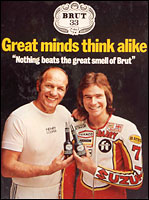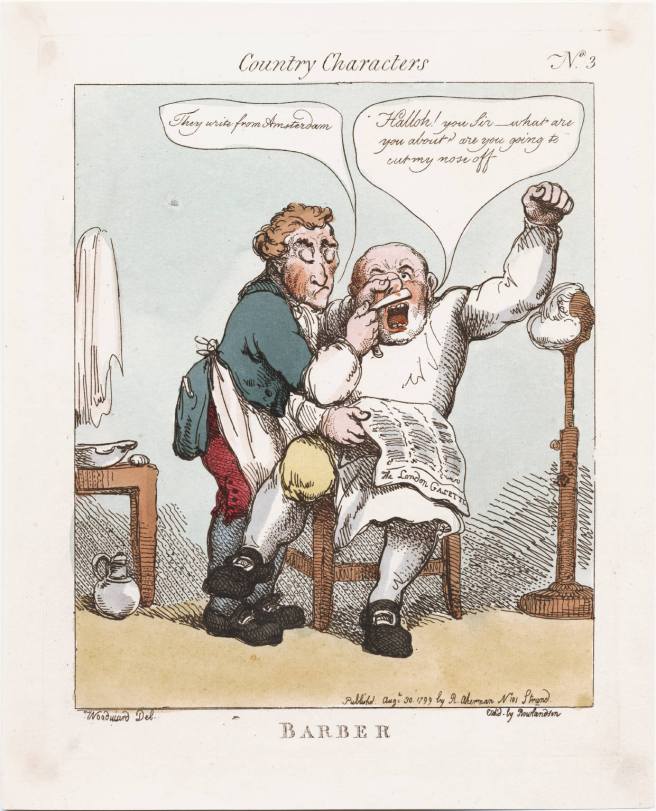In a recent article in the UK’s Independent newspaper, the cosmetics industry for men in Britain was estimated to be worth over £30 million a year, after growing over 300% in 2014/15. Even so, this is a drop in the ocean, in a global market for male pampering which accounts for an eye-watering 14.8 BILLION pounds per year. The sheer numbers of male aftershaves, scents and colognes are bewildering, and carry the heft of major league celebrity endorsements, from the likes of David Beckham and Johnny Depp.
I’m a child of the 70s, a time when aftershave choices were, shall we say, limited. At Christmas and birthdays my poor father was the regular recipient of a) Brut b) Blue Stratos or C) Old Spice, with a runner’s up prize of ‘Denim’ if Boots had run out of any of them. This was despite the fact that he had (and still has) a beard!

As for celebrity endorsements, these were also fairly limited. In the Brut corner was Former British Heavyweight boxer Henry Cooper, who invited you to ‘splash it all over’, alongside mulleted football star Kevin Keegan and the accident-prone superbike champion, Barry Sheen. None perhaps matched the kitsch glamour of Tabac’s advert with the sartorially elegant, and magnificently coiffured, Peter Wyngarde – star of the ‘Jason King’ series.

How long, though, has aftershave been with us? Have men always slapped on the scent or slathered on the lotion after shaving? In fact, shaving preparations have a surprisingly long history and, more than this, can actually tell us some important things about attitudes to men’s personal grooming.
Before the eighteenth century, the concept of applying ‘product’ as a means to beautify the skin after shaving simply didn’t exist. Shaving was a basic, quotidian activity, done for necessity. It was also probably a painful experience. Rather than shaving themselves, men visited the barber, whose services were available everywhere from large towns and cities to small villages. The quality of the shave available differed dramatically, leading to satires about the clumsy barber whose razors were as blunt as oyster knives. It is possible that some provision might be made to soothe the skin after the shave, or maybe apply a little lavender water, but evidence for individual shaving routines is fairly sparse.

(Image copyright Lewis Walpole Library)
Nevertheless, there were options within domestic medicine, which might allow men to soothe their suppurating skin once the barber had done with it. Even in the sixteenth and seventeenth centuries, remedy collections included recipes for beauty washes and pastes, and ‘washballs’ for the skin. There are some great examples on ‘Madam Gilflurt’s’ blog: http://www.madamegilflurt.com/2016/05/bathing-in-age-of-extravagance-make.html Although usually meant for women, there was nothing in principal preventing men from slathering on some home-made preparation to calm their skin.
The later eighteenth century, however, saw things begin to change. The disappearance of beards meant that shaving was not only more common, but was beginning to be done by individuals, as well as the barber. The appearance of new, sharper types of steel razor made this a more comfortable experience. But it also gave rise to a new market. Whilst razor makers saw opportunities in targeting men who shaved themselves, perfumers and hairdressers jumped on the bandwagon and started to puff their own products for young shavers.
In 1752 Richard Barnard of Temple Bar claimed to be the inventor of the ‘True original shaving powder’. A rival powder, advertised the same year by J. Emon, claimed to ‘make razors cut easy and [was] very good for tender faces’. The perfumer Charles Lillie’s 1744 advertisements for ‘Persian (or Naples) soap’ claimed to be extremely useful in soothing smarting skin after shaving, while others like ‘Paris Pearl Water’ was claimed to freshen men’s skin and brighten their complexion. Perhaps the most exotic sounding was “Elenora’s Lavo Cream” advertised in 1801, which was ‘particularly agreeable to Gentlemen after shaving, as it cools and heals the remaining heats’.

There was, however, a delicate balancing act to male toilet. On the one hand was the need to conform to expectations of polite manliness. Neatness of appearance, elegance, a smooth, open countenance and a grasp of etiquette and manners were all expected of the polite gentleman. On the other, there were fears that British men were slipping into effeminacy, too affected by Frenchified fashions and adopted airs. Overuse of cosmetics was satirised in cartoons of the extreme form of eighteenth-century manhood – the Macaroni, or Fop. Interestingly though, shaving was strongly connected with masculinity and manly self-control. It was part of the expected conduct of a gentleman; a little bit of cream to soothe delicate features was perfectly acceptable.
Fast forward to the 1850s, though, and beards were back with a vengeance. Given that Victorian men were sporting huge crops of beard en masse, the concept of aftershave might seem to have been redundant. It is worth remembering though (thinking of the current beard trend) that for all the beard wearers there were probably still many who preferred to shave. In fact, even at the height of the beard movement a number of aftershave lotions and scents were available.

(Glasgow Herald, 7th June 1852)
From the 1820s right through the rest of the century, a popular product was Rowland’s Kalydor, advertised widely in various newspapers and publications. A variety of testimonials accompanied the advertisement. “One of our first physicians, sixty years of age, whose face was in a continual state of inflammation, so as to render shaving impossible, has been entirely cured and is much gratified’. Other types of product were available; an advert in the Literary Digest heralded a particular brand of talcum powder which ‘positively won’t show white on the face’, making you ‘feel cool fresh and clean’.
Some played upon the popularity of science to claim the efficacy of their products. ‘Carter’s Botanic Shaving Soap’ was supposedly the ‘result of many years study and practical experiment’ by its creator, and advertisements played on its neutralisation of alkalis (which ‘made shaving a torture to all who have a delicate and tender skin’).

(More associated with mouthwash today, Listerine was originally used as shaving lotion. Image from WWW.Kilmerhouse.com)
The ingredients in some preparations contained tried and tested ingredients like glycerine to soothe the face. ‘Cherry Laurel lotion’ containing distilled cherry laurel water, rectified spirit, glycerine and distilled water, ‘used to allay irritation of the skin, particularly after shaving’. Others included ‘Lotion Prussic Acid’ and the equally unattractive-sounding ‘essence of bitter almonds’. The problem with these particular substances was the ingredients. Both, according to an 1873 study of cosmetics by Arnold Cooley, contained the deadly potassium cyanide – and made worse by the fact that the liquids apparently tasted very pleasant. Cooley suggested that both products should correctly be labelled ‘Poison’!
By way of conclusion it’s worth mentioning that aftershaves have been blamed for all manner of ills. In 1963, a GP (Dr B.E. Finch from London) wrote to the British Medical Journal, noting that several patients (mostly young men) had reported symptoms of dizziness after shaving, similar to “slight intoxication, similar to that which occurs after imbibing an alcoholic drink”. On further investigation Finch found this to be a common occurrence, and theorized that alcohol-based aftershaves were being absorbed through the shaven skin, causing mild intoxication. A reply in the following month’s edition suggested that, due to the highly volatile nature of those liquids, it was more likely the fumes than the absorption that were causing the problem!

Reblogged this on Dr Alun Withey and commented:
One from the archives – something very much on my mind at the moment, as I look at the history of men’s cosmetic products.
Fascinating!